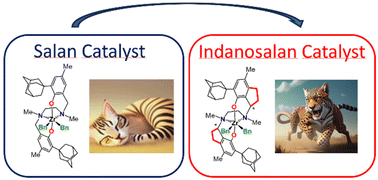Manipulating pre-equilibria in olefin polymerization catalysis: backbone-stiffening converts a living into a highly active salan-type catalyst†
Abstract
Stiffening of the catalyst backbone of salan-type catalyst 1via ring closure yields indanosalan 3 and increases activity and molar mass capability by two orders of magnitude. In propene polymerization, catalyst 3 is highly isotactic selective and nearly as active as one of the most productive known salan-catalysts today (2), showing much higher molar mass capability. NMR studies provide evidence of the identity of the active metal-polymeryl species for the catalyst pair 1/3, explaining their vast activity differences: the traditional salan catalyst 1 is trapped in the inactive mer–mer configuration, while indanosalan 3 prefers the active fac–fac isomer.



 Please wait while we load your content...
Please wait while we load your content...